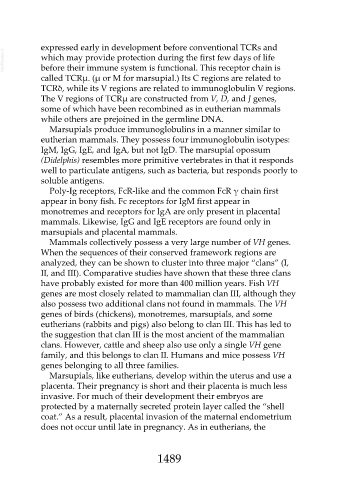Page 1489 - Veterinary Immunology, 10th Edition
P. 1489
expressed early in development before conventional TCRs and
VetBooks.ir which may provide protection during the first few days of life
before their immune system is functional. This receptor chain is
called TCRµ. (µ or M for marsupial.) Its C regions are related to
TCRδ, while its V regions are related to immunoglobulin V regions.
The V regions of TCRµ are constructed from V, D, and J genes,
some of which have been recombined as in eutherian mammals
while others are prejoined in the germline DNA.
Marsupials produce immunoglobulins in a manner similar to
eutherian mammals. They possess four immunoglobulin isotypes:
IgM, IgG, IgE, and IgA, but not IgD. The marsupial opossum
(Didelphis) resembles more primitive vertebrates in that it responds
well to particulate antigens, such as bacteria, but responds poorly to
soluble antigens.
Poly-Ig receptors, FcR-like and the common FcR γ chain first
appear in bony fish. Fc receptors for IgM first appear in
monotremes and receptors for IgA are only present in placental
mammals. Likewise, IgG and IgE receptors are found only in
marsupials and placental mammals.
Mammals collectively possess a very large number of VH genes.
When the sequences of their conserved framework regions are
analyzed, they can be shown to cluster into three major “clans” (I,
II, and III). Comparative studies have shown that these three clans
have probably existed for more than 400 million years. Fish VH
genes are most closely related to mammalian clan III, although they
also possess two additional clans not found in mammals. The VH
genes of birds (chickens), monotremes, marsupials, and some
eutherians (rabbits and pigs) also belong to clan III. This has led to
the suggestion that clan III is the most ancient of the mammalian
clans. However, cattle and sheep also use only a single VH gene
family, and this belongs to clan II. Humans and mice possess VH
genes belonging to all three families.
Marsupials, like eutherians, develop within the uterus and use a
placenta. Their pregnancy is short and their placenta is much less
invasive. For much of their development their embryos are
protected by a maternally secreted protein layer called the “shell
coat.” As a result, placental invasion of the maternal endometrium
does not occur until late in pregnancy. As in eutherians, the
1489

